2012 Peugeot 3008 Hybrid 4 air condition
[x] Cancel search: air conditionPage 4 of 284
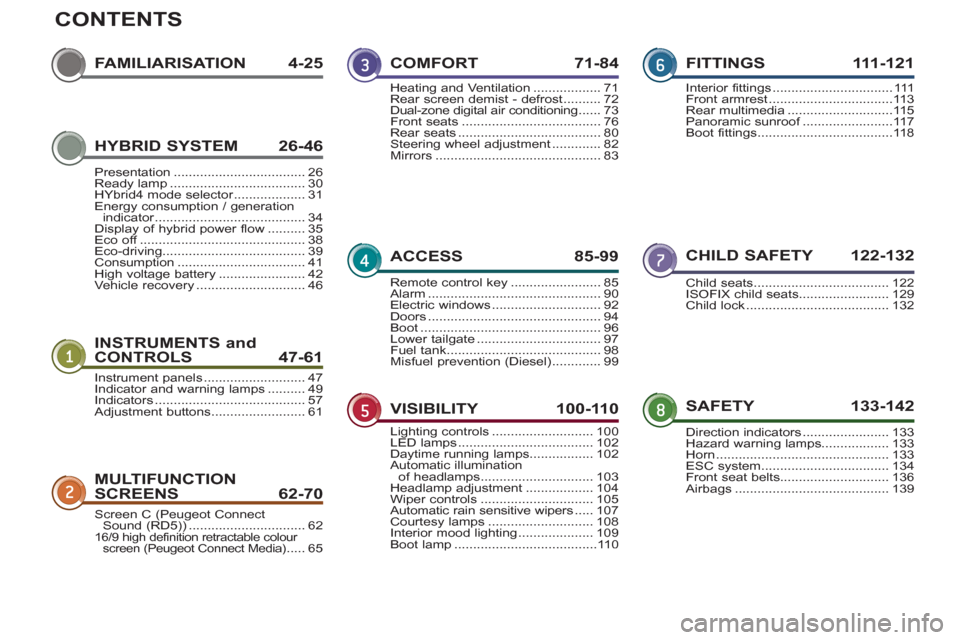
CONTENTS
FAMILIARISATION 4-25
IN
STRUMENTS and
CONTROLS 47-61
CHILD SAFETY 122-132
MULTIFUNCTION
SCREEN
S62-70
SAFETY 133-142 COMFORT 71-8
4
ACCESS 85-99
VISIBILITY 100-110FITTINGS 111-12
1
Instrument panels...........................47Indicator and warning lamps..........49Indicators........................................57Adjustment buttons.........................61
Child seats....................................122ISOFIX child seats........................129Child lock ......................................132
Screen C (Peugeot ConnectSound (RD5))...............................6216/9 high definition retractable colour
screen (Peugeot Connect Media).....65
Direction indicators.......................133Hazard warning lamps..................133Horn ..............................................133ESC system..................................134Front seat belts.............................136Airbags .........................................139
Heating and Ventilation ..................71Rear screen demist - defrost..........72Dual-zone digital air conditioning......73Front seats .....................................76Rear seats......................................80Steering wheel adjustment.............82Mirrors............................................83
Remote control key........................85Alarm ..............................................90Electric windows.............................92Doors..............................................94Boot................................................96Lower tailgate.................................97Fuel tank.........................................98Misfuel prevention (Diesel) .............99
Lighting controls...........................100LED lamps ....................................102Daytime running lamps.................102Automatic illumination
of headlamps..............................103Headlamp adjustment..................104Wiper controls ..............................105Automatic rain sensitive wipers .....107Courtesy lamps............................108Interior mood lighting....................109Boot lamp......................................110
Interior fittings................................111Front armrest.................................113Rear multimedia............................115Panoramic sunroof........................f117Boot fittings....................................118HYBRID SYSTEM 26-46
Presentation...................................26Ready lamp....................................30HYbrid4 mode selector...................r31Energy consumption / generationindicator........................................r34Display of hybrid power flow..........35Eco off............................................f38Eco-driving......................................39Consumption ..................................41High voltage battery.......................42Vehicle recovery.............................46
Page 10 of 284
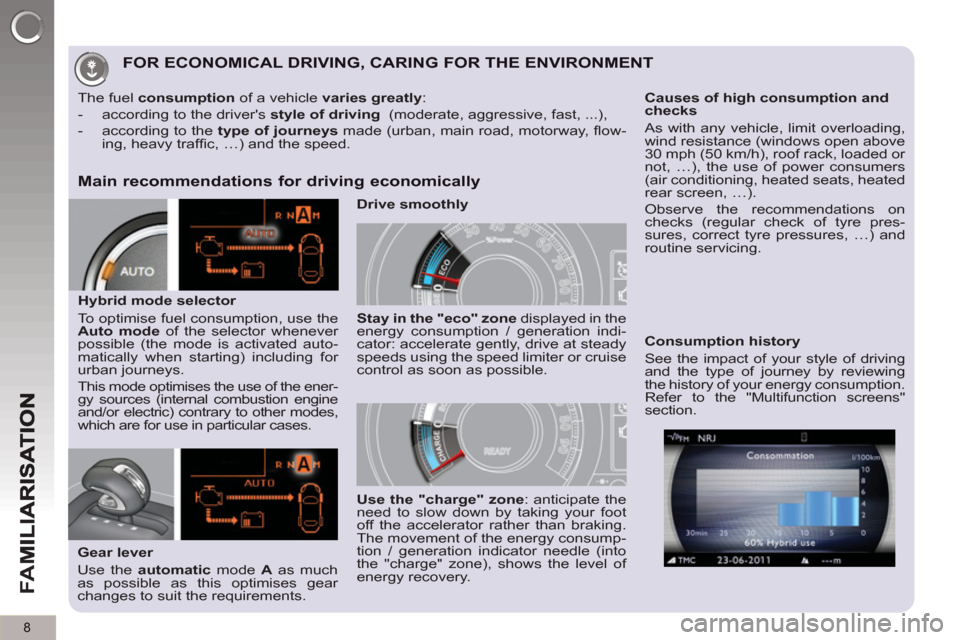
8
FA
M
FOR ECONOMICAL DRIVING, CARING FOR THE ENVIRONMENT
Main recommendations for driving economically
Gear lever
Use the automatic
mode A
as much
as possible as this optimises gear
changes to suit the requirements.
The fuel consumption
of a vehicle varies greatly
:
- according to the driver's style of driving
(moderate, aggressive, fast, ...),
- according to the type of journeys
made (urban, main road, motorway, fl ow-
ing, heavy traffi c, …) and the speed.
Hybrid mode selector
To optimise fuel consumption, use the
Auto
mode
of the selector whenever
possible (the mode is activated auto-
matically when starting) including for
urban journeys.
This mode optimises the use of the ener-
gy sources (internal combustion engine
and/or electric) contrary to other modes,
which are for use in particular cases.
Stay in the "eco" zone
displayed in the
energy consumption / generation indi-
cator: accelerate gently, drive at steady
speeds using the speed limiter or cruise
control as soon as possible.
Causes of high consumption and
checks
As with any vehicle, limit overloading,
wind resistance (windows open above
30 mph (50 km/h), roof rack, loaded or
not, …), the use of power consumers
(air conditioning, heated seats, heated
rear screen, …).
Observe the recommendations on
checks (regular check of tyre pres-
sures, correct tyre pressures, …) and
routine servicing.
Consumption history
See the impact of your style of driving
and the type of journey by reviewing
the history of your energy consumption.
Refer to the "Multifunction screens"
section.
Use the "charge"
zone: anticipate the
need to slow down by taking your foot
off the accelerator rather than braking.
The movement of the energy consump-
tion / generation indicator needle (into
the "charge" zone), shows the level of
energy recovery.
Drive smoothly
Page 14 of 284
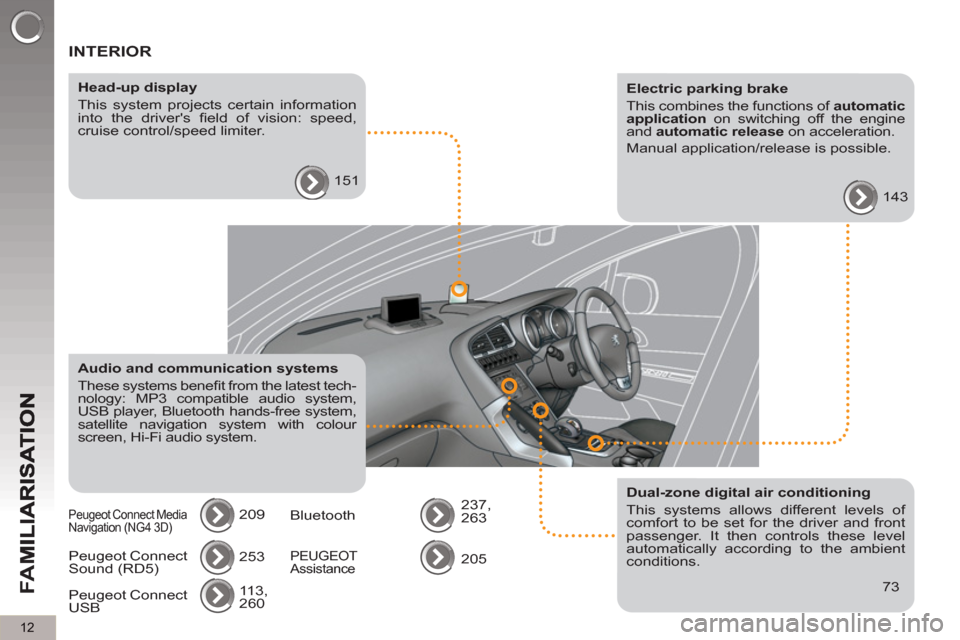
12
FA
M
INTERIOR
Electric parking brake
This combines the functions of automatic
application
on switching off the engine
and automatic release
on acceleration.
Manual application/release is possible.
143
Audio and communication systems
These systems benefi t from the latest tech-
nology: MP3 compatible audio system,
USB player, Bluetooth hands-free system,
satellite navigation system with colour
screen, Hi-Fi audio system.
209
Dual-zone digital air conditioning
This systems allows different levels of
comfort to be set for the driver and front
passenger. It then controls these level
automatically according to the ambient
conditions.
73 Peugeot Connect
Sound (RD5) 253
113,
260 Peugeot Connect
USB
Peugeot Connect Media
Navigation (NG4 3D) Bluetooth 237,
263
PEUGEOT
Assistance 205
Head-up display
This system projects certain information
into the driver's fi eld of vision: speed,
cruise control/speed limiter.
151
Page 15 of 284
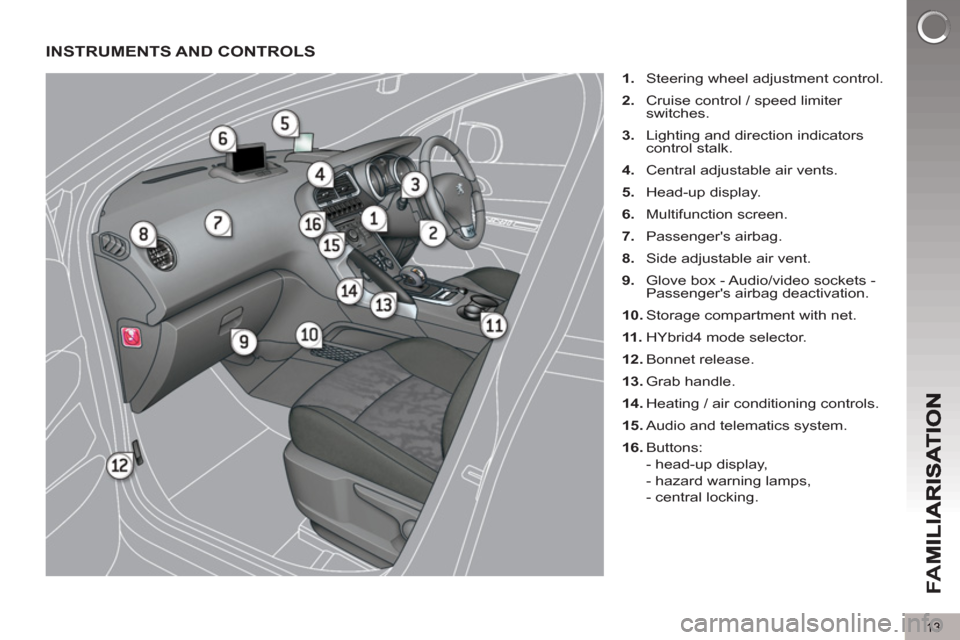
13
FA
M
INSTRUMENTS AND CONTROLS
1.
Steering wheel adjustment control.
2.
Cruise control / speed limiter
switches.
3.
Lighting and direction indicators
control stalk.
4.
Central adjustable air vents.
5.
Head-up display.
6.
Multifunction screen.
7.
Passenger's airbag.
8.
Side adjustable air vent.
9.
Glove box - Audio/video sockets -
Passenger's airbag deactivation.
10.
Storage compartment with net.
11 .
HYbrid4 mode selector.
12.
Bonnet release.
13.
Grab handle.
14.
Heating / air conditioning controls.
15.
Audio and telematics system.
16.
Buttons:
- head-up display,
- hazard warning lamps,
- central locking.
Page 39 of 284
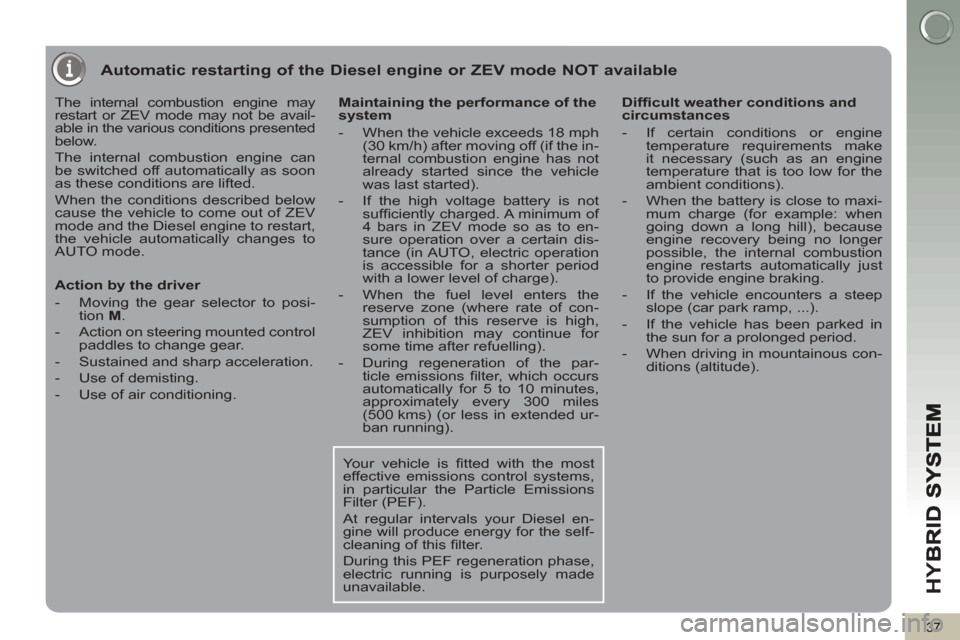
HY
B
37
Automatic restarting of the Diesel engine or ZEV mode NOT available
The internal combustion engine may
restart or ZEV mode may not be avail-
able in the various conditions presented
below.
The internal combustion engine can
be switched off automatically as soon
as these conditions are lifted.
When the conditions described below
cause the vehicle to come out of ZEV
mode and the Diesel engine to restart,
the vehicle automatically changes to
AUTO mode.
Action by the driver
- Moving the gear selector to posi-
tion M
.
- Action on steering mounted control
paddles to change gear.
- Sustained and sharp acceleration.
- Use of demisting.
- Use of air conditioning.
Maintaining the performance of the
system
- When the vehicle exceeds 18 mph
(30 km/h) after moving off (if the in-
ternal combustion engine has not
already started since the vehicle
was last started).
- If the high voltage battery is not
suffi ciently charged. A minimum of
4 bars in ZEV mode so as to en-
sure operation over a certain dis-
tance (in AUTO, electric operation
is accessible for a shorter period
with a lower level of charge).
- When the fuel level enters the
reserve zone (where rate of con-
sumption of this reserve is high,
ZEV inhibition may continue for
some time after refuelling).
- During regeneration of the par-
ticle emissions fi lter, which occurs
automatically for 5 to 10 minutes,
approximately every 300 miles
(500 kms) (or less in extended ur-
ban running).
Diffi cult weather conditions and
circumstances
- If certain conditions or engine
temperature requirements make
it necessary (such as an engine
temperature that is too low for the
ambient conditions).
- When the battery is close to maxi-
mum charge (for example: when
going down a long hill), because
engine recovery being no longer
possible, the internal combustion
engine restarts automatically just
to provide engine braking.
- If the vehicle encounters a steep
slope (car park ramp, ...).
- If the vehicle has been parked in
the sun for a prolonged period.
- When driving in mountainous con-
ditions (altitude).
Your vehicle is fi tted with the most
effective emissions control systems,
in particular the Particle Emissions
Filter (PEF).
At regular intervals your Diesel en-
gine will produce energy for the self-
cleaning of this fi lter.
During this PEF regeneration phase,
electric running is purposely made
unavailable.
Page 40 of 284
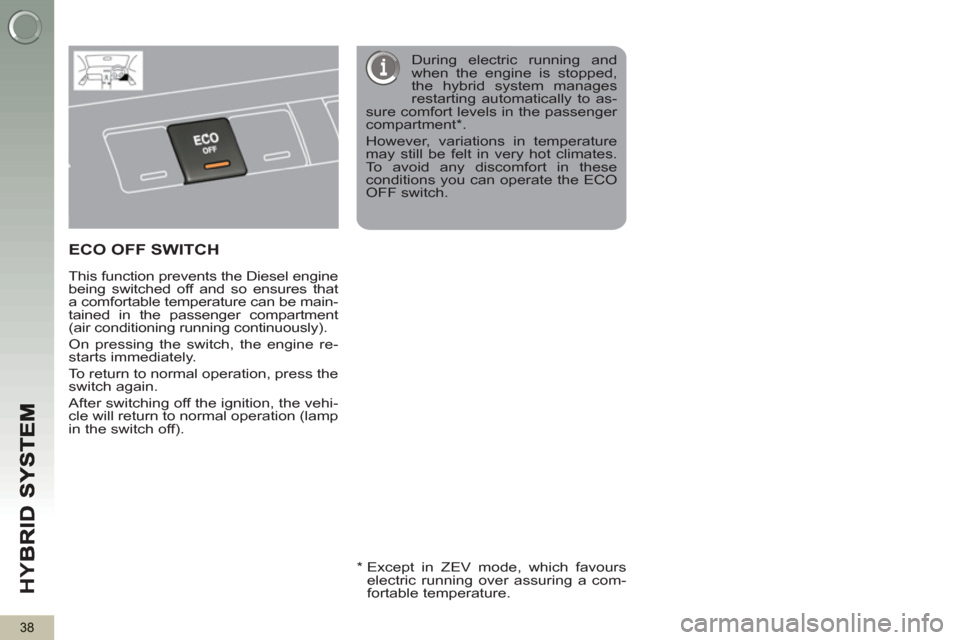
HY
B
38
ECO OFF SWITCH
This function prevents the Diesel engine
being switched off and so ensures that
a comfortable temperature can be main-
tained in the passenger compartment
(air conditioning running continuously).
On pressing the switch, the engine re-
starts immediately.
To return to normal operation, press the
switch again.
After switching off the ignition, the vehi-
cle will return to normal operation (lamp
in the switch off).
During electric running and
when the engine is stopped,
the hybrid system manages
restarting automatically to as-
sure comfort levels in the passenger
compartment * .
However, variations in temperature
may still be felt in very hot climates.
To avoid any discomfort in these
conditions you can operate the ECO
OFF switch.
*
Except in ZEV mode, which favours
electric running over assuring a com-
fortable temperature.
Page 41 of 284
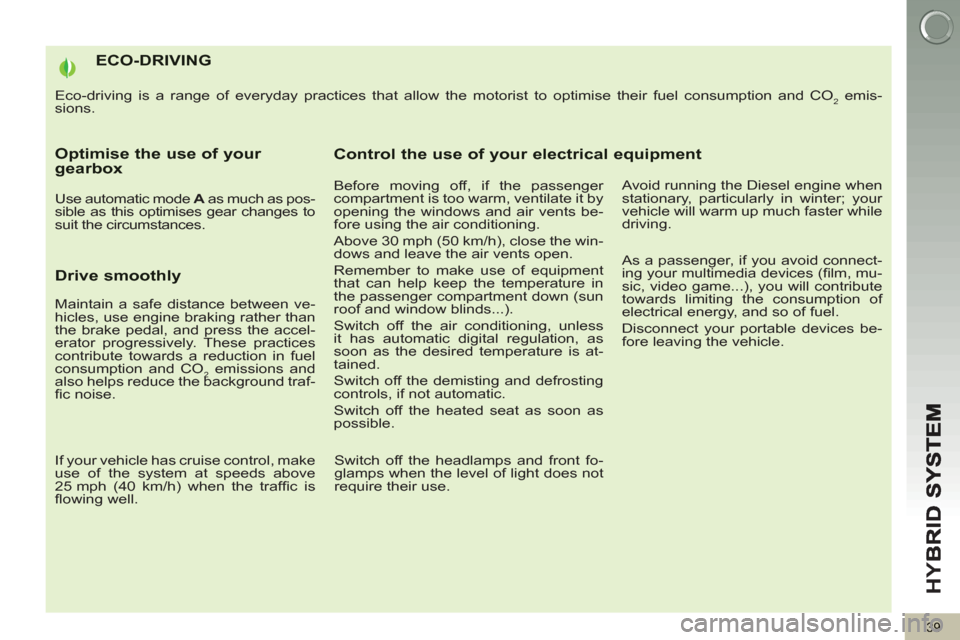
HY
B
39
ECO-DRIVING
Eco-driving is a range of everyday practices that allow the motorist to optimise their fuel consumption and CO2 emis-
sions.
Optimise the use of your gearbox
Use automatic mode A
as much as pos-
sible as this optimises gear changes to
suit the circumstances.
Drive smoothly
If your vehicle has cruise control, make
use of the system at speeds above
25 mph (40 km/h) when the traffi c is
fl owing well.
Control the use of your electrical equipment
Before moving off, if the passenger
compartment is too warm, ventilate it by
opening the windows and air vents be-
fore using the air conditioning.
Above 30 mph (50 km/h), close the win-
dows and leave the air vents open.
Remember to make use of equipment
that can help keep the temperature in
the passenger compartment down (sun
roof and window blinds...).
Switch off the air conditioning, unless
it has automatic digital regulation, as
soon as the desired temperature is at-
tained.
Switch off the demisting and defrosting
controls, if not automatic.
Switch off the heated seat as soon as
possible.
Switch off the headlamps and front fo-
glamps when the level of light does not
require their use.
Avoid running the Diesel engine when
stationary, particularly in winter; your
vehicle will warm up much faster while
driving.
As a passenger, if you avoid connect-
ing your multimedia devices (fi lm, mu-
sic, video game...), you will contribute
towards limiting the consumption of
electrical energy, and so of fuel.
Disconnect your portable devices be-
fore leaving the vehicle.
Maintain a safe distance between ve-
hicles, use engine braking rather than
the brake pedal, and press the accel-
erator progressively. These practices
contribute towards a reduction in fuel
consumption and CO
2 emissions and
also helps reduce the background traf-
fi c noise.
Page 73 of 284
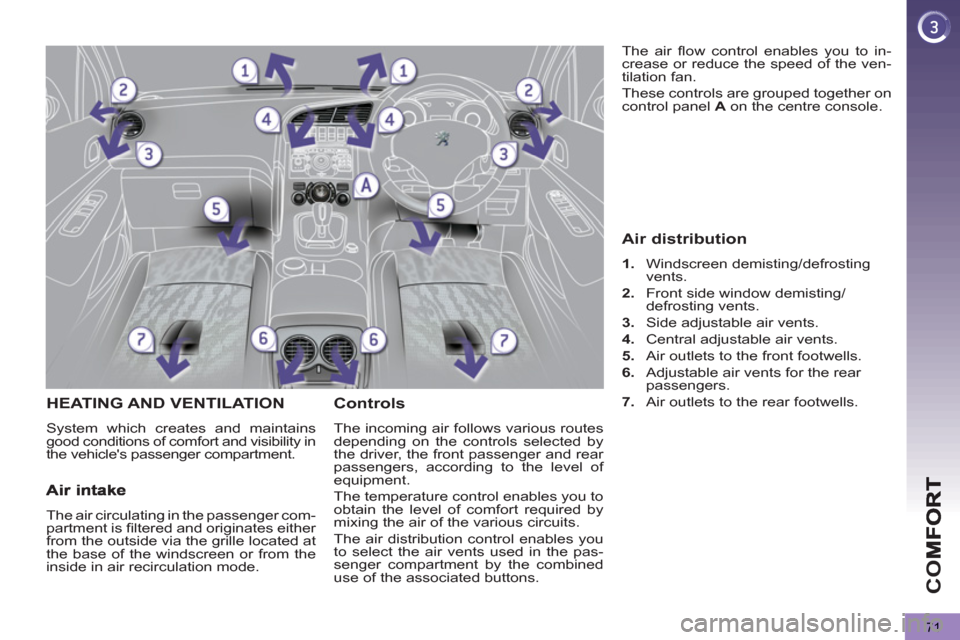
CO
71
HEATING AND VENTILATION
System which creates and maintains
good conditions of comfort and visibility in
the vehicle's passenger compartment.
Controls
The incoming air follows various routes
depending on the controls selected by
the driver, the front passenger and rear
passengers, according to the level of
equipment.
The temperature control enables you to
obtain the level of comfort required by
mixing the air of the various circuits.
The air distribution control enables you
to select the air vents used in the pas-
senger compartment by the combined
use of the associated buttons. The air fl ow control enables you to in-
crease or reduce the speed of the ven-
tilation fan.
These controls are grouped together on
control panel A
on the centre console.
The air circulating in the passenger com-
partment is fi ltered and originates either
from the outside via the grille located at
the base of the windscreen or from the
inside in air recirculation mode.
Air distribution
1.
Windscreen demisting/defrosting
vents.
2.
Front side window demisting/
defrosting vents.
3.
Side adjustable air vents.
4.
Central adjustable air vents.
5.
Air outlets to the front footwells.
6.
Adjustable air vents for the rear
passengers.
7.
Air outlets to the rear footwells.